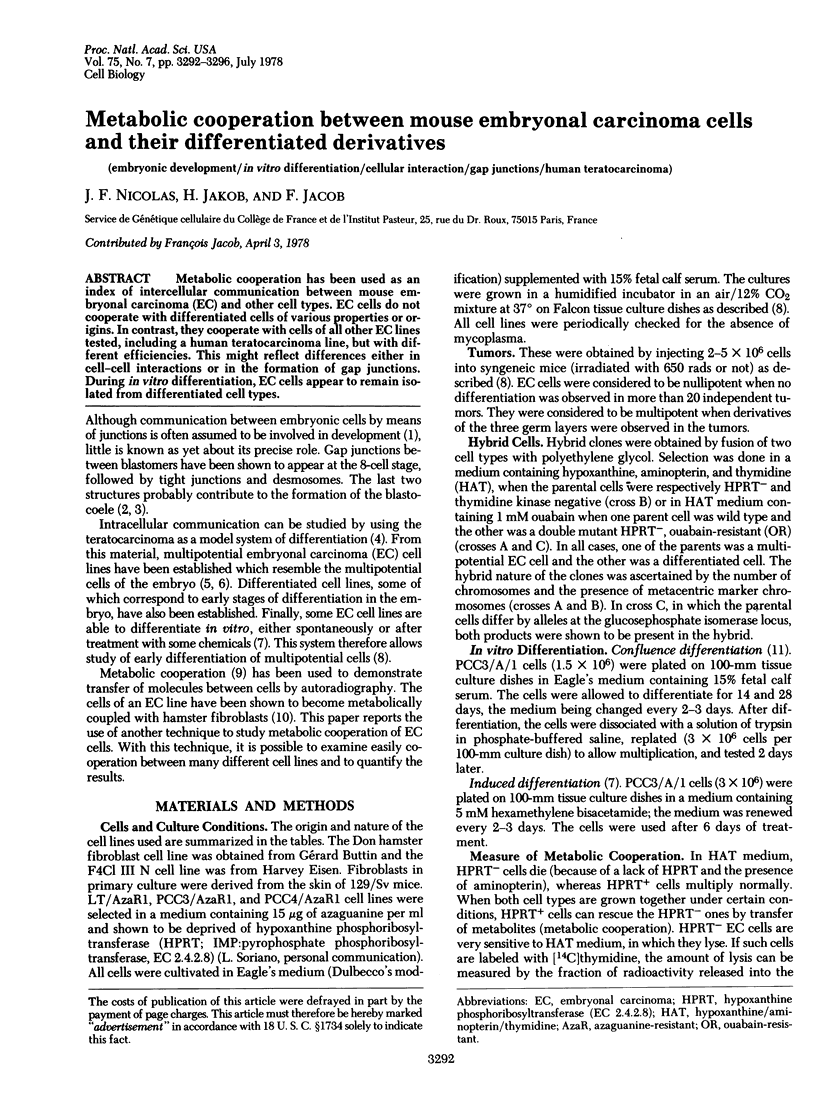Abstract
Metabolic cooperation has been used as an index of intercellular communication between mouse embryonal carcinoma (EC) and other cell types. EC cells do not cooperate with differentiated cells of various properties or origins. In contrast they cooperate with cells of all other EC lines tested, including a human teratocarcinoma line, but with different efficiencies. This might reflect differences either in cell-cell interactions or in the formation of gap junctions. During in vitro differentiation, EC cells appear to remain isolated from differentiated cell types.
Full text
PDF




Selected References
These references are in PubMed. This may not be the complete list of references from this article.
- Artzt K., Dubois P., Bennett D., Condamine H., Babinet C., Jacob F. Surface antigens common to mouse cleavage embryos and primitive teratocarcinoma cells in culture. Proc Natl Acad Sci U S A. 1973 Oct;70(10):2988–2992. doi: 10.1073/pnas.70.10.2988. [DOI] [PMC free article] [PubMed] [Google Scholar]
- Avner P., Dubois P., Nicolas J. F., Jakob H., Gaillard J., Jacob F. Mouse teratocarcinoma. Carbon source utilization patterns for growth and in vitro differentiation. Exp Cell Res. 1977 Mar 1;105(1):39–50. doi: 10.1016/0014-4827(77)90150-1. [DOI] [PubMed] [Google Scholar]
- Ducibella T., Albertini D. F., Anderson E., Biggers J. D. The preimplantation mammalian embryo: characterization of intercellular junctions and their appearance during development. Dev Biol. 1975 Aug;45(2):231–250. doi: 10.1016/0012-1606(75)90063-9. [DOI] [PubMed] [Google Scholar]
- Fentiman I., Taylor-Papadimitriou J., Stoker M. Selective contact-dependent cell communication. Nature. 1976 Dec 23;264(5588):760–762. doi: 10.1038/264760a0. [DOI] [PubMed] [Google Scholar]
- Gilula N. B., Reeves O. R., Steinbach A. Metabolic coupling, ionic coupling and cell contacts. Nature. 1972 Feb 4;235(5336):262–265. doi: 10.1038/235262a0. [DOI] [PubMed] [Google Scholar]
- Hogan B., Fellous M., Avner P., Jacob F. Isolation of a human teratoma cell line which expresses F9 antigen. Nature. 1977 Dec 8;270(5637):515–518. doi: 10.1038/270515a0. [DOI] [PubMed] [Google Scholar]
- Holden S., Bernard O., Artzt K., Whitmore W. F., Jr, Bennett D. Human and mouse embryonal carcinoma cells in culture share an embryonic antigen (F9). Nature. 1977 Dec 8;270(5637):518–520. doi: 10.1038/270518a0. [DOI] [PubMed] [Google Scholar]
- Hooper M. L., Slack C. Metabolic co-operation in HGPRT+ and HGPRT- embryonal carcinoma cells. Dev Biol. 1977 Feb;55(2):271–284. doi: 10.1016/0012-1606(77)90172-5. [DOI] [PubMed] [Google Scholar]
- Jacob F. Mouse teratocarcinoma and embryonic antigens. Immunol Rev. 1977 Jan;33:3–32. doi: 10.1111/j.1600-065x.1977.tb00360.x. [DOI] [PubMed] [Google Scholar]
- Jacob F. The Leeuwenhoek Lecture, 1977. Mouse teratocarcinoma and mouse embryo. Proc R Soc Lond B Biol Sci. 1978 May 16;201(1144):249–270. doi: 10.1098/rspb.1978.0044. [DOI] [PubMed] [Google Scholar]
- Jakob H., Dubois P., Eisen H., Jacob F. Effets de l'hexaméthylènebisacétamide sur la différenciation de cellules de carcinome embryonnaire. C R Acad Sci Hebd Seances Acad Sci D. 1978 Jan;286(1):109–111. [PubMed] [Google Scholar]
- Lehman J. M., Speers W. C., Swartzendruber D. E., Pierce G. B. Neoplastic differentiation: characteristics of cell lines derived from a murine teratocarcinoma. J Cell Physiol. 1974 Aug;84(1):13–27. doi: 10.1002/jcp.1040840103. [DOI] [PubMed] [Google Scholar]
- Magnuson T., Demsey A., Stackpole C. W. Characterization of intercellular junctions in the preimplantation mouse embryo by freeze-fracture and thin-section electron microscopy. Dev Biol. 1977 Dec;61(2):252–261. doi: 10.1016/0012-1606(77)90296-2. [DOI] [PubMed] [Google Scholar]
- Miller R. A., Ruddle F. H. Teratocarcinoma X friend erythroleukemia cell hybrids resemble their pluripotent embryonal carcinoma parent. Dev Biol. 1977 Mar;56(1):157–173. doi: 10.1016/0012-1606(77)90159-2. [DOI] [PubMed] [Google Scholar]
- Mintz B., Illmensee K. Normal genetically mosaic mice produced from malignant teratocarcinoma cells. Proc Natl Acad Sci U S A. 1975 Sep;72(9):3585–3589. doi: 10.1073/pnas.72.9.3585. [DOI] [PMC free article] [PubMed] [Google Scholar]
- Nicolas J. F., Avner P., Gaillard J., Guenet J. L., Jakob H., Jacob F. Cell lines derived from teratocarcinomas. Cancer Res. 1976 Nov;36(11 Pt 2):4224–4231. [PubMed] [Google Scholar]
- Nicolas J. F., Dubois P., Jakob H., Gaillard J., Jacob F. Tératocarcinome de la souris: différenciation en culture d'une lignée de cellules primitives a potentialités multiples. Ann Microbiol (Paris) 1975 Jan;126(1):3–22. [PubMed] [Google Scholar]
- Pitts J. D., Burk R. R. Specificity of junctional communication between animal cells. Nature. 1976 Dec 23;264(5588):762–764. doi: 10.1038/264762a0. [DOI] [PubMed] [Google Scholar]
- Stevens L. C. The development of transplantable teratocarcinomas from intratesticular grafts of pre- and postimplantation mouse embryos. Dev Biol. 1970 Mar;21(3):364–382. doi: 10.1016/0012-1606(70)90130-2. [DOI] [PubMed] [Google Scholar]
- Stevens L. C., Varnum D. S. The development of teratomas from parthenogenetically activated ovarian mouse eggs. Dev Biol. 1974 Apr;37(2):369–380. doi: 10.1016/0012-1606(74)90155-9. [DOI] [PubMed] [Google Scholar]
- Subak-Sharpe H., Bürk R. R., Pitts J. D. Metabolic co-operation between biochemically marked mammalian cells in tissue culture. J Cell Sci. 1969 Mar;4(2):353–367. doi: 10.1242/jcs.4.2.353. [DOI] [PubMed] [Google Scholar]


